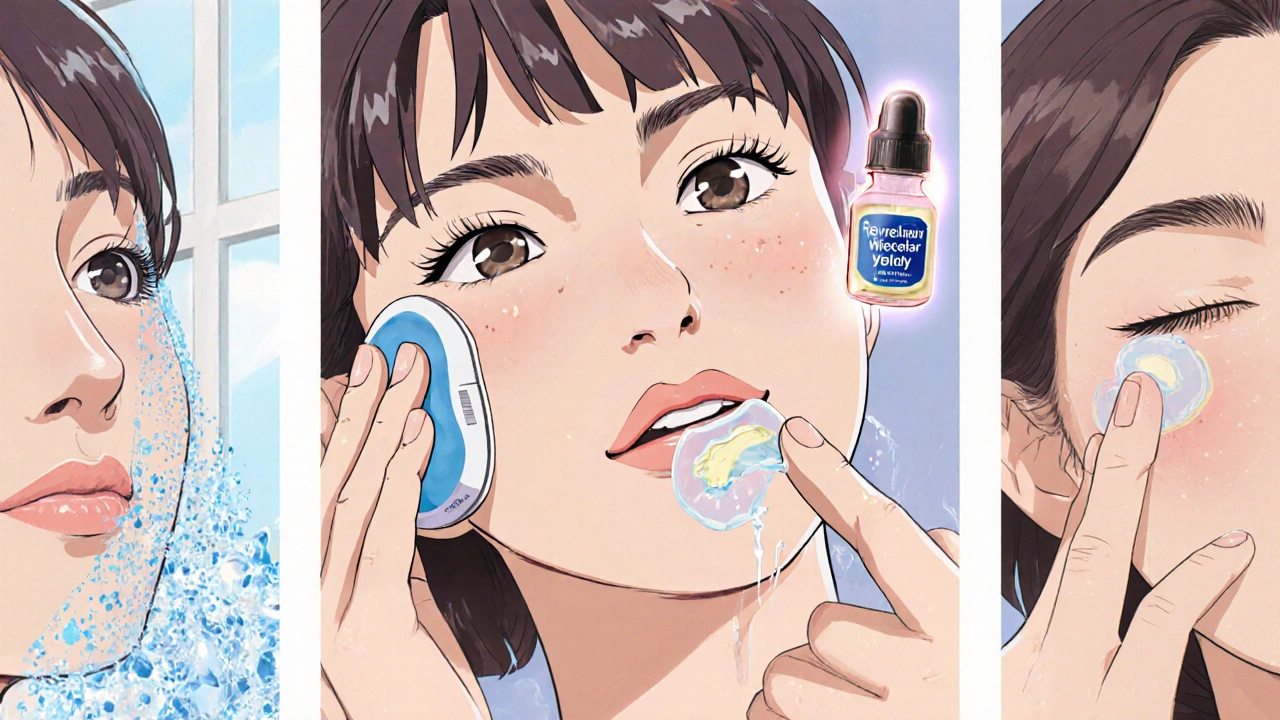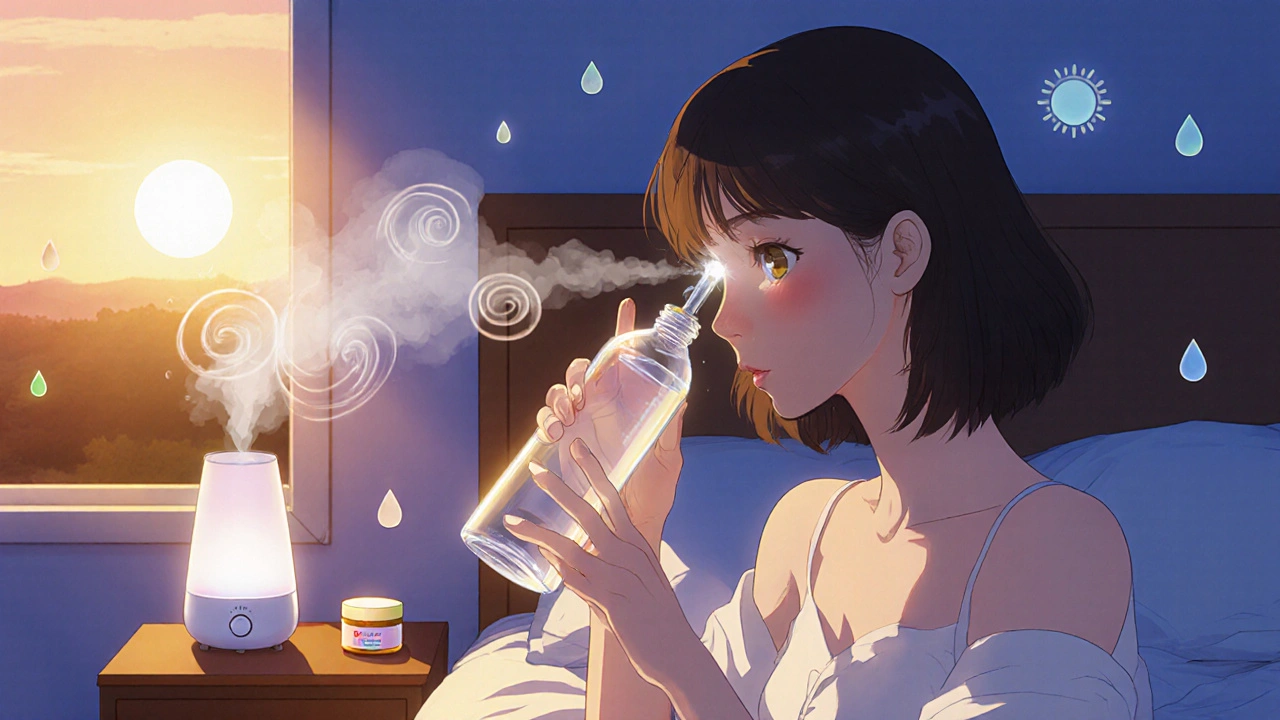Treat Chapped Skin Around Eyes and Lips: Proven Remedies & Tips
 Oct, 21 2025
Oct, 21 2025
When your chapped skin is a condition where the skin loses moisture, becomes dry, cracked and uncomfortable, the delicate zones around the eyes and lips often suffer the most.
Why the eye and lip zones crack so easily
The eye area includes the thin skin of the eyelids and the skin right under the brow bone is only about 0.5 mm thick-much thinner than the skin on your cheek or forearm. It contains fewer oil glands, so it can’t replenish its natural lipid barrier as quickly. The lip area is made of cutaneous mucosa that lacks a true cornified layer, meaning it never develops the protective keratin coating that ordinary skin has. Combine that with frequent licking, exposure to wind, low humidity, and occasional allergic reactions, and you’ve got a perfect recipe for cracking.
Common triggers you can control
- Dry indoor heating during fall and winter.
- Cold, windy outdoor weather that strips surface moisture.
- Over‑cleansing with harsh soaps or makeup removers.
- Allergic contact dermatitis from fragrance‑laden eye creams.
- Habitual licking of lips or rubbing the eye area.
Identifying which of these you’re exposed to is the first step toward lasting relief.
Key skin‑care concepts: emollients, humectants, and occlusives
Three categories of ingredients work together to rebuild a healthy barrier:
- Emollient softens and smooths the skin by filling gaps between skin cells.
- Humectant draws water from the deeper layers of skin and the environment into the outermost layer.
- Occlusive creates a physical barrier that locks moisture in.
When you choose a product, look for a blend of all three. Below is a quick side‑by‑side look at four popular options.
| Product | Emollient | Humectant | Occlusive | Best for |
|---|---|---|---|---|
| Petroleum jelly | Mineral oil | None | Very high | Night‑time sealing |
| Lanolin balm | Lanolin | Glycerin | Medium | Dry, cracked lips |
| Ceramide‑rich cream | Ceramides | Hyaluronic acid | Low‑medium | Sensitive eye skin |
| Hyaluronic acid serum + light ointment | Shea butter | Hyaluronic acid (high) | Low | Day‑time hydration |

Step‑by‑step home‑remedy routine
- Cleanse gently. Use a fragrance‑free micellar water or a mild, sulfate‑free cleanser. Pat dry with a soft cotton towel-no rubbing.
- Apply a thin layer of Petroleum jelly an occlusive that locks in moisture for up to 8 hours to the edge of the lips. For the eye area, use a fingertip‑size dab of a ceramide‑rich eye cream.
- Seal the barrier. If you’re outside in wind or heat, add a second layer of lanolin balm over the lip area after 30 minutes. For the eyes, wait 10 minutes, then lightly tap a humectant‑rich serum (containing hyaluronic acid) onto the orbital rim.
- Re‑apply every 2‑3 hours in dry environments. Keep a small tube in your purse or desk drawer for quick touch‑ups.
- Nightly repair. Before bed, wash off any makeup, then apply a generous coat of a thick ointment (petroleum jelly or a ceramide balm). Sleep on a humidifier set to 40‑50 % RH.
Over‑the‑counter products worth buying
If you prefer ready‑made formulas, look for the following label claims:
- "Contains at least 3 % ceramides" - supports the skin’s lipid matrix.
- "Fragrance‑free, hypoallergenic" - reduces risk of contact dermatitis.
- "Includes glycerin or hyaluronic acid" - provides humectant action.
- "Non‑comedogenic" - especially important for the delicate eye area.
Brands such as CeraVe, Aquaphor, and Burt’s Bees have specific eye‑lip friendly lines that meet these criteria.

When to see a dermatologist
Most chapped skin heals with proper barrier care, but seek professional help if you notice any of these red flags:
- Bleeding or oozing that doesn’t improve after a week.
- Severe itching accompanied by swelling.
- Crusting that spreads beyond the eye‑lip region.
- Persistent redness that looks like eczema or psoriasis.
A dermatologist can prescribe topical steroids, prescription‑strength moisturizers, or evaluate for underlying conditions such as atopic dermatitis.
Prevention: habits that keep your skin supple
- Stay hydrated - aim for 2 L of water daily.
- Use a humidifier in heated rooms, especially during winter.
- Apply a broad‑spectrum sunscreen to the eye area every morning; UV damage accelerates barrier loss.
- Swap harsh facial wipes for soft reusable cotton pads soaked in mild cleanser.
- Resist the urge to lick lips; keep a flavored lip balm handy instead.
Small daily tweaks add up to a stronger, more resilient skin barrier.
Can I use regular hand cream on my eye area?
Hand creams are often too heavy and may contain fragrances that irritate the delicate eye skin. Stick to eye‑specific or fragrance‑free formulas that list ceramides, hyaluronic acid, or mineral oil as key ingredients.
Is it safe to apply petroleum jelly directly on my eyelids?
Yes, a thin layer is safe for most people and creates an excellent occlusive barrier. Avoid getting it into the eye itself; use a clean fingertip and dab away from the lash line.
How often should I reapply moisturizer in dry weather?
Every 2-3 hours is a good rule of thumb. If you’re outdoors or in an air‑conditioned office, keep a travel‑size tube handy for quick touch‑ups.
What natural oils are safe for the lip area?
Pure, cold‑pressed coconut oil, sweet almond oil, and jojoba oil are all safe and provide emollient benefits. Pair them with a thin layer of lanolin or petroleum jelly to trap the moisture.
When should I consider prescription treatment?
If cracks persist beyond two weeks despite diligent barrier care, or if you see signs of infection (redness, swelling, pus), book an appointment. A doctor may prescribe a mild steroid or a medicated ointment to break the cycle.


Jake Hayes
October 21, 2025 AT 00:51Petroleum jelly is the gold standard; its occlusive layer locks moisture for up to eight hours, so apply a thin film before bed and you’ll stop cracking. Pair it with a ceramide‑rich eye cream in the morning for optimal barrier repair.
parbat parbatzapada
October 21, 2025 AT 01:57i cant believe the big‑pharma lobby pushes scented eye creams while they keep the real barrier‑boosters like lanolin hidden. they want you to keep buying overpriced moisturizers instead of simple petroleum jelly. stop licking your lips and start using a cheap lanolin balm, it’s the truth they don’t want you to know.
Eryn Wells
October 21, 2025 AT 04:11Hey everyone 😊, let’s remember that every skin type is unique, so test any new product on a small patch before full application. Using fragrance‑free, ceramide‑rich formulas can help keep the eye‑lip area comfortable for everyone. Stay hydrated and keep that humidifier on, it makes a huge difference! 🌟
Kathrynne Krause
October 21, 2025 AT 05:17Absolutely! 🌈 A splash of color in your routine can be motivating – think of a bright lip balm that doubles as a reminder to reapply. Mix a dab of shea butter with a few drops of jojoba oil for a DIY night‑time seal; it feels luxurious and keeps that barrier happy.
Vivian Annastasia
October 21, 2025 AT 07:31Wow, thank you for the groundbreaking insight about re‑applying every two to three hours – I never would have guessed that the air‑conditioner isn’t a friend. Guess I’ll just keep cracking while you guys bask in your flawless skin.
John Price
October 21, 2025 AT 08:04Reapply every two hours when you're in a dry office.
Nick M
October 21, 2025 AT 10:17Honestly, the whole routine sounds like a full‑blown pharmaceutical pipeline. You’re basically doing a skin‑care protocol that could be classified as a minor clinical trial. If you want to avoid the jargon, just stick to a cheap petroleum jelly and call it a day.
eric smith
October 21, 2025 AT 10:51Sure, because everyone needs a masterclass in barrier science from a random comment. Maybe you should write a book titled ‘How to Overcomplicate Moisturizing for Dummies.’ Thanks for the lecture.